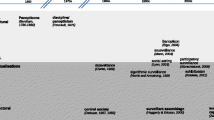Abstract
This article analyses the way in which websites of conservation foundations organise the affective investments of viewers in animals by the use of webcams. Against a background of—often overly—general speculation on the influence of electronic media on our engagement with the world, it focuses on one particular practice where this issue is at stake. Phenomenological investigation is supplemented with ethnographic observation of user practice. It is argued that conservation websites provide caring spaces in two interrelated ways: by providing affective spaces where users’ feelings are evoked, articulated and organised; and by opening up ethical space where the beauty of animals appears as an incentive to care. As an alternative to thinking of on- and off-line places as clearly delineated and of bodies and technologies as separate entities, the analysis focuses on trajectories of engagement that cut through these in various directions. In actual acts of looking and being affected, users, animals, places and technologies are intimately entwined. The article further suggests how focussing on trajectories of involvement can be developed to evaluate various websites and their user activity in relationship to clearly defined goals, e.g. conservation goals.
Similar content being viewed by others
References
Armitage P. (2003) The show must go on!. Ripple Effect 4, South Africa
Berger J. (1980) Why look at animals? About looking. Pantheon, New York
Campanella T. J. (2000) Eden by wire: Webcams and the telepresent landscape. In: Goldberg K. (ed.) The robot in the garden. Telerobotics and telepistemology in the age of the internet. MIT, Cambridge, MA, pp 22–46
Currier D. (2003) Feminist technological futures: Deleuze and body/technology assemblages. Feminist Theory 3(4): 321–338
Grossberg L. (1992) We gotta get out of this place. Routledge, London
Hills, M. (2001). Virtually out there: On-line fandom. In R. Munt Sally, Technospaces: Inside the new media (pp. 147–160). London/New York: Continuum.
Hine C. (2000) Virtual ethnography. Sage, London
Iacoboni M. (2008) Mirroring people—The new science of how we connect with others. Farrar, STRAUS & Giroux, New York
Ihde D. (1990) Technology and the lifeworld: From garden to earth. Indiana University Press, Bloomington
Kamphof, I. (2009). Real time: On the whereabouts of time in new media. The case of webcams. In: N. Vandeusen, & B. Schomakers (Eds.), Time. Space. Structure. Leiden: Brill (to appear in 2009/2010).
Lacan J. (1977) Écrits. W.W. Norton, New York
Lévy P. (1998) Becoming virtual: Reality in the digital age. Plenum Trade, London
Lyon D. (2001) Surveillance society. Monitoring every day life. Open University Press, Buckingham
Lyotard J.-F. (1991) The inhuman. Reflections on time. Stanford University Press, Stanford
Lyotard J.-F. (1994) Lessons on the analytic of the sublime. Stanford University Press, Stanford
Macgregor Wise J. (2004) An immense and unexpected field of action. Webcams, surveillance and everyday life. Cultural Studies 2/3(18): 424–442
Malamud R. (1998) Reading zoos. Presentation of animals and captivity. New York University Press, New York
McPherson T. (2002) Reload. Liveness, mobility and the web. In: Mirzoeff N. (ed.) The visual culture reader. Routledge, London, pp 458–470
Merleau-Ponty M. (1962) Phenomenology of Perception. London & New York, Routledge
Scarry, E. (1998). On beauty and being just. The Tanner Lectures on Human Values. Retrieved March 6, 2009 from: http://www.tannerlectures.utah.edu/lectures/index.html.
Sobchack V. (1992) The address of the eye. A phenomenology of film experience. Princeton University Press, Princeton
Sobchack V. (2004) Carnal thoughts. Embodiment and moving image culture. University of California Press, Berkeley
Virilio P. (1994) The vision machine. Indiana University Press, Bloomington
Virilio P. (1995) The art of the motor. University of Minnesota Press, Minneapolis
Virilio P. (2002) The visual crash. In: Levin T. Y., Frohne U., Weibel P. (eds) Ctrl [Space]. Rhetorics of surveillance from Bentham to big brother. ZKM, Karlsruhe, pp 108–113
Author information
Authors and Affiliations
Corresponding author
Rights and permissions
About this article
Cite this article
Kamphof, I. Webcams to Save Nature: Online Space as Affective and Ethical Space. Found Sci 16, 259–274 (2011). https://doi.org/10.1007/s10699-010-9194-7
Published:
Issue Date:
DOI: https://doi.org/10.1007/s10699-010-9194-7




